It's been a while since I've had an opportunity to post, so this is going to cover a few items.
So firstly, There was a close conjunction of Jupiter and the moon, so I grabbed a shot at 250mm
And just to check I could still do it, a handheld 250mm shot of the moon
Over the course of the last couple of weeks, I've been able to grab a few shots of the moon with the 450d, a 2xTC, the C80ED and my camera tripod
and in colour, testing out some of the features of Aperture, I think this is possibly my best to date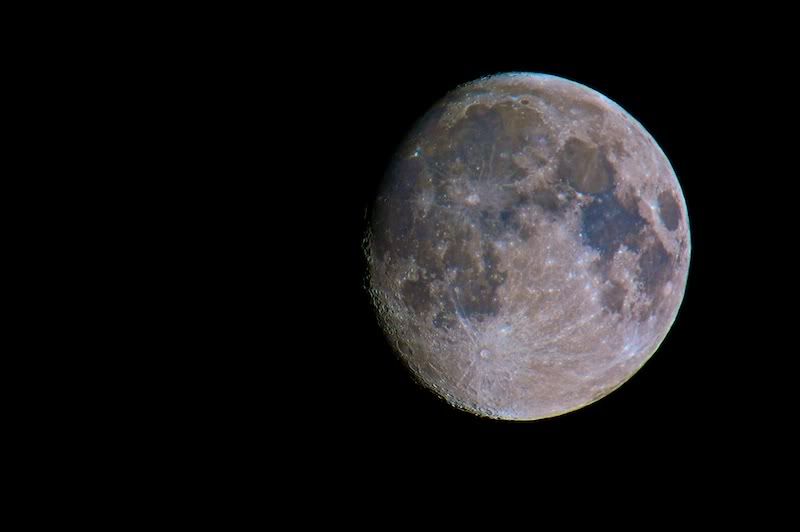
One on a misty night, the mist processes out nicely with a wallop of contrast
but here's the unprocessed version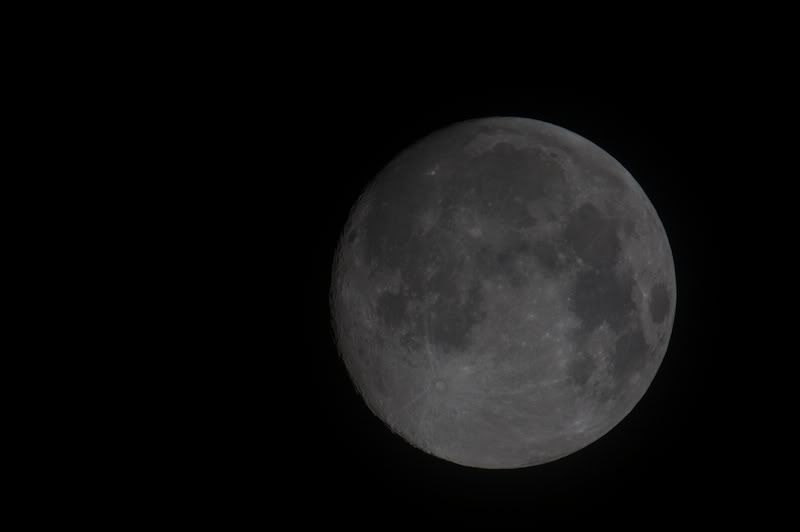
And then, a lovely moon against the daytime sky
I was also able to get out for a little webcam action in between the clouds one night. Thankfully, the Skymax SLT combo, is small, lightweight and very easy to setup, as this means it can be done very quickly without any need to see Polaris.
These are not great, but if I remember correctly, the clouds were being a pain. I'm also at about the limit of my little webcam, I'm not sure what to do really, I'd like an imaging source cam, but that's not going to happen at the moment..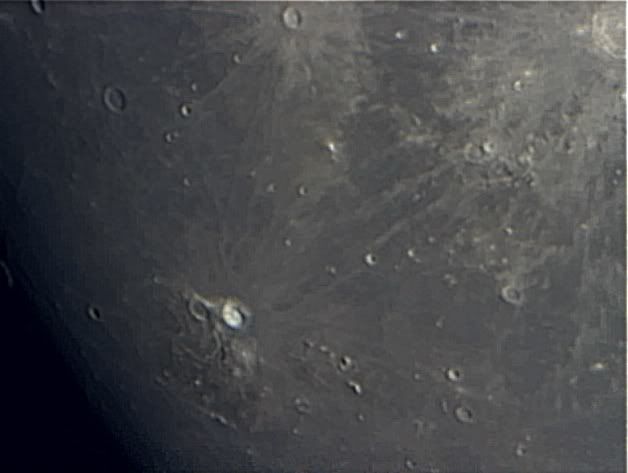
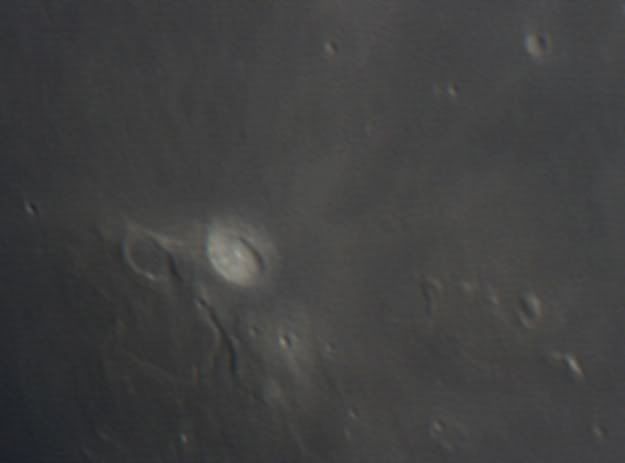
I don't know why, but I really rather like this area of the moon.
I also had a short visual session with my youngest one evening, before the clouds moved in. Jupiter was low in the sky, but we'd been talking about it, why the moon and Jupiter were lit when we had night time, and that you could see the main bands quite easily. So I got the C80ED setup on my camera tripod on the driveway and we had a good look at Jupiter and the moon with my 5mm Hyperion. The bands on Jupiter were clear and three moons were visibly. I did try pushing the power up with a barlow, but the seeing, and the lowness meant it was way too much power. But never mind. With the simple expedient of drawing a line on the drawtube with a pencil, putting the scope back into focus for the SLR was a doddle, and in fact, it turns out that the Hyperion with diagonal is almost parfocal with the SLR and 2" extension tube.
And finally, we had a clear night, decently clear too, so that I could see the milky way unaided. I couldn't quite make out M31. So I carted out the rig for a run on M31. Everything started well, level and PA'ed easily. A quick check of focus and all good. Manually set to M31, but not on the chip... I decided I couldn't be bothered trying to work it out (what with lights still being on in the house, so setup CdC and ran a 3 star align. The first problem hit me... The joystick on the gamepad only worked on one axis... Gonna have to see if I can fix that. Using the touchpad on the laptop for fine adjustments is a real pain. Still after a few minutes, all aligned, so slew to M31. Plonked almost in the centre of the viewfinder, so a quick ISO1600, 60s test frame to check, and I set PHD off to work. Using a 1 sec loop was more than enough to locate a guide star, in fact, I could see the core of M31 on the screen. Anyway, guiding off and running, I setup to take a sequence of 6 minute exposures. I opted to use ISO400 as an experiment, and to see if the higher dynamic range of the sensor would make any difference, it did, but more on that shortly.
After a while, and a check on power, I realised the battery on the lappy was going to run out, way before my powertank... that's a first, I'm not sure why, but my powertank now seems to be working better. I really do have to sort out mains power, but I want to get a large plastic container big enough to house the lappy and keep the dew off, although the simple expedient of hanging a tea towel over the LCD worked a treat on this occasion.
Then I hit my next issue. Whilst taking flats, the CLS is making for much longer flats, the CLS clip filter, decided it didn't want to clip anymore, and I heard it fall down inside the OTA, bouncing on the baffles as it went. All I can see is it's a good job the baffles were there, as they prevented the filter smacking into the back of the objective. Of course, with the clip filter no longer in the camera, there was no point trying to capture any more flats, if I tried to put the filter back, the orientation would be different. I removed the camera, and capped it, popped the rear cap on the OTA, and carefully pointed the lens at the Zenith... the filter fell back on the soft plastic of the rear cap, undamaged... phew...
Then after clearing up, I downloaded the images, and set to work on processing. Then the problems really began. I kept getting a weird grid showing through the image. First stack was Lights and Flats, as I've done for the other images. Obviously something was going on, so I put my Bias master frame in, still there.. Odd... I setup the camera in the garage and took a sequence of darks, still there. Each occasion, involved two attempts at processing post stack. In the end, I took the final stack, and tried to be as gentle as possible, yet push the data as far as I could (all good processing experience) and I managed to not bring the grid out. The noise was astonishing, given that ISO400 should induce less noise in the subs. I can only conclude that whilst ISO400 is less noisy in capture, the lower amplification of the signal in camera meant that to get the data out required far harder stretching, and I know from ordinary underexposed captures, this shows a lot more noise in the shadows...
After that experiment, I'm going to go back to using ISO800 and stay there. The noise and image is easier to deal with... Anyway, here's the end result. 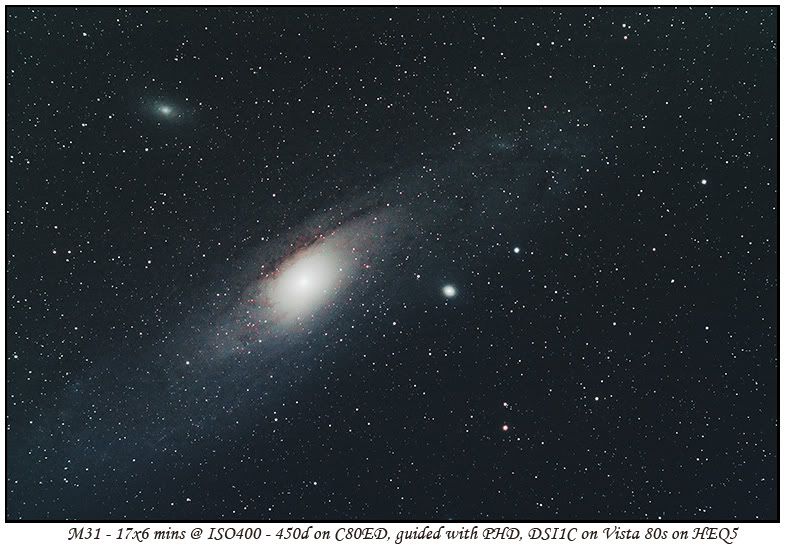
Now, I want to get more data on this one, another night at ISO800 should do it... Then onto M33, and after that M45... I want to get the Merope Nebula.
Sunday, 11 October 2009
A general update
Subscribe to:
Post Comments (Atom)







No comments:
Post a Comment